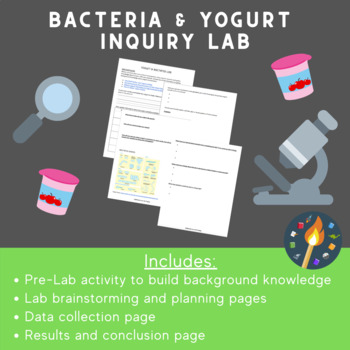Bacteria Inquiry Yogurt Lab
- PDF
What educators are saying
Description
Need to introduce the concept of cells or review the characteristics of life before you jump into bacteria? Check out my highly popular Intro to Cells Reading Passage!
Moving on to Eukaryotes next? Reinforce student vocabulary with The Nucleus: A Science Reading Passage!
What is this Product?
This product guides students in designing and carrying out an inquiry lab using yogurt, a microscope, and background knowledge of bacteria. Students first read or watch some informational texts to gather information about how yogurt is made, and then describe that process, including the role of bacteria, in their own words.
Next, students explore available yogurt samples and record their characteristics, including present bacteria strains and other information (fat-free, flavored, etc.). They then develop some testable questions that they might seek to answer about bacteria using these yogurt samples and a microscope. Finally, students plan and carry out an investigation to answer one of the questions they developed.
What is Included?
- Pre-Lab page where students gather background knowledge about the yogurt-making process and available yogurt samples
- Lab brainstorming and planning pages
- Data collection page
- Results and conclusion page
How Can I Use This Product?
Students in my class complete this lab early on in our bacteria unit, after they've been introduced to basic concepts but well before any final assessment.
I provide students with anywhere from 6-10 different types and/ or brands of yogurt (the individual cups were more than enough for 100+ students), and I try to select a range of fat free, low-fat, whole fat, greek, icelandic, and australian styles. I stick to white-colored yogurts (vanilla, coconut, etc.) with no added fruit chunks so students can more easily stain and view the samples.
Students are encouraged to think outside the box with their testable question ideas, and I have occasionally provided additional materials per student request such as antibacterial disinfectant products, access to a microwave and freezer, etc., depending on what students wish to test.
Students really enjoy this lab and gain some interesting insights about bacteria and their optimal living conditions. In total, from student planning to bringing in materials and conducting the lab, this takes about 2-3 hour-long class periods.





